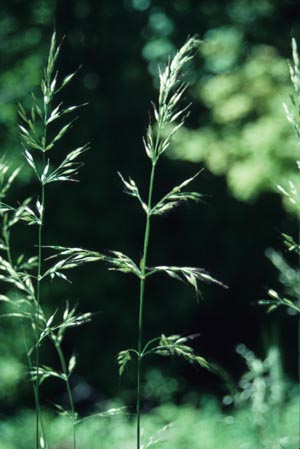Tall Oatgrass

Common Name(s):
Tall Oatgrass
Scientific Name:
Arrhenatherum elatius (L.) Beauv. ex J.& K. Presl
Scientific Name Synonyms:
None known
Symbol:
AREL3
Description:
Life Span: Perennial
Origin: Introduced
Season: Cool
Growth Characteristics: Tall oatgrass is a loosely-tufted grass with erect, smooth stems 28-70 inches tall that are occasionally bulblike at the base. It is sometimes rhizomatous. It begins growth in early spring and remains green late into the fall.
Seedhead: Its seedhead is a panicle 3-12 inches long and up to 3 inches wide, green, shiny and sometimes purple-tinged. Panicle branches are 6-8” long, whorled and usually spikelet-bearing to the base. Spikelets have 2 florets and are narrow, glistening and about 3/8 inch long. The lower male or neuter floret has a lemma with a stout, twisted, geniculate awn. The upper female floret has a bristle-tipped lemma. The two florets fall together as a unit when dropped. The glumes are membranous and shorter than the lower floret to longer than the upper one.
Leaves: Leaf blades are 2-12 inches long by 1/8 – 1/3 inch wide, flat and smooth or rarely hairy or rough. Ligules are short, square and hairlike. Sheaths are smooth.
Ecological Adaptions:
Tall oatgrass is found along roads and streams, in fields and seeded areas in oak-sagebrush, aspen, spruce-fir, ponderosa pine and meadow communities at elevations from 4,200-10,000 feet’ where annual precipitation is >=16”.
Soils: It is adapted to soils that are medium to fine in texture and is rarely found growing in sandy soils.
Associated Species: Associated species include orchardgrass, intermediate wheatgrass, smooth brome and timothy.
Uses and Management:
Tall oatgrass was introduced into North America as a pasture grass in 1807. It has become naturalized in many parts of the country. It provides abundant forage for livestock and wildlife but is somewhat sensitive to grazing pressure. It has been used fairly extensively in land revegetation efforts. Seed is readily available and relatively inexpensive.

